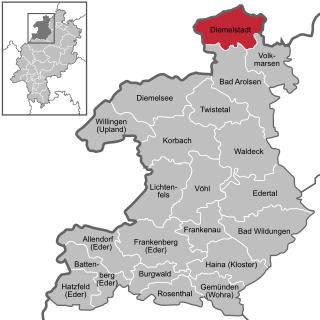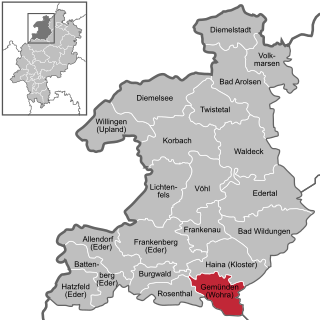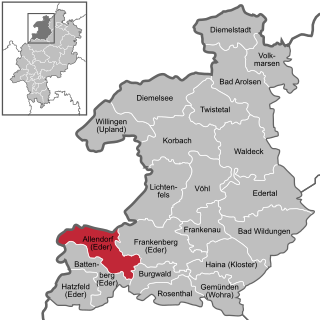Hochsauerlandkreis is a Kreis (district) in the east of North Rhine-Westphalia, Germany. Neighboring districts are Soest, Paderborn, Höxter, Waldeck-Frankenberg, Siegen-Wittgenstein, Olpe, Märkischer Kreis.
Waldeck-Frankenberg is a Kreis (district) in the north of Hesse, Germany. Neighbouring districts are Höxter, Kassel, Schwalm-Eder, Marburg-Biedenkopf, Siegen-Wittgenstein, Hochsauerland.

Bad Arolsen is a small town in northern Hesse, Germany, in Waldeck-Frankenberg district. From 1655 until 1918 it served as the residence town of the Princes of Waldeck-Pyrmont and then until 1929 as the capital of the Waldeck Free State. The International Tracing Service has its headquarters in Bad Arolsen. In 2003, the town hosted the 43rd Hessentag state festival.

Battenberg (Eder) is a small town in Waldeck-Frankenberg district, the state of Hesse, Germany. The town is noted for giving its name to the Battenberg family, a morganatic branch of the ruling House of Hesse-Darmstadt, and through it, the name Mountbatten used by members of the British royal family, a literal translation of Battenberg.

Korbach, officially the Hanseatic City of Korbach, is the district seat of Waldeck-Frankenberg in northern Hesse, Germany. It is over a thousand years old and is located on the German Timber-Frame Road. In 2018, the town has hosted the 58th Hessentag state festival.

Hatzfeld (Eder) is a small town in Waldeck-Frankenberg district in Hesse, Germany.

Willingen is a municipality in Waldeck-Frankenberg in northern Hesse, Germany, some 80 km west of Kassel.

Hallenberg is a town in the Hochsauerland district, in North Rhine-Westphalia, Germany.

Frankenberg an der Eder is a town in Waldeck-Frankenberg district, Hesse, Germany.
Allendorf may refer to the following places:

Diemelstadt is a small town in Waldeck-Frankenberg district in Hesse, Germany.

Frankenau is a small town in Waldeck-Frankenberg district in Hesse, Germany.

Gemünden is a town in Waldeck-Frankenberg district in Hesse, Germany.

Allendorf (Eder) is a municipality which situated in the north west of Hesse, Germany. The municipality is within the Waldeck-Frankenberg district in a rural region called the upper Eder Valley. The Burgwald range is located west of Allendorf while the Breite Struth hills are in Allendorf's east.

Volkmarsen[ˈfɔlkˌmaʁzn̩] is a small town in Waldeck-Frankenberg district in northern Hesse, Germany. It is home to 6840 residents.

Burgwald is a municipality in Waldeck-Frankenberg in Hesse, Germany.

Diemelsee is a municipality in Waldeck-Frankenberg in northwest Hesse, Germany, and is part of the low mountain region called Upland. Adorf is the seat of this municipality.

Waldeck is an electoral constituency represented in the Bundestag. It elects one member via first-past-the-post voting. Under the current constituency numbering system, it is designated as constituency 167. It is located in northern Hesse, comprising most of the Landkreis Kassel district and the northern part of the Waldeck-Frankenberg district.
The Eder Uplands refers to a region in North Hesse in Germany. It covers several municipalities that lies around the upper reaches of the Eder river on the edge of the Rothaar Mountains. The Eder Uplands includes a large part of the old county of Frankenberg, which was absorbed into Waldeck-Frankenberg in the wake of the administrative reforms.



















